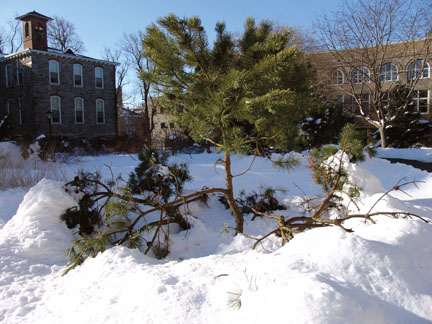Big Snow

After 28.2 inches of snow, the branches of a mugo pine (Pinus mugo ‘Enci’) in the John W. Nason Garden are splayed out from the snow load. Curator of the Arboretum Collection Andrew Bunting is hopeful that the shrub will recover.
There’s almost nothing more magical than the sight of snowflakes drifting earthward, dancing on air currents, swirling and swooping, settling softly on the branches of trees and leaves, glistening on blades of grass. Mysterious and perfectly crystalline, they hold the promise of a white world of enchantment, of excitement and fun, snowballs, sledding, skiing, frozen artworks…. But sometimes, the magic has a dark side.
Snowflakes began to fall on campus during the evening of Feb. 5—lovely as ever. This time, they portended a snowfall even more awe-inspiring than usual because of its sheer magnitude. Accompanied by blizzard-strength gales, these snowflakes whirled and spiraled, fast and furious. The blinding snow kept falling and falling—for 24 hours, covering the Philadelphia area in a blanket that was 28½ inches deep, according to reports from local television news stations.
Regional buses, trains, and airplanes came to a standstill. Drivers were advised to stay off roads to permit plows to work unhampered.
While many students had fun, Swarthmore’s facilities staff worked around the clock, fighting against the storm to clear campus pathways and areas around buildings, so that the College—which held fast to its policy of not cancelling classes—could continue to function.
And it did, for the following five days.
Then, Nature delivered an unsolicited encore. Another blizzard, this time with wetter, heavier snow—17 more inches of it.
The beauty of a snow-covered campus after the storms was tempered by a number of problems that arose because of them.
Disappointingly, the Faculty and Friends Dance Concert, scheduled for Feb. 6, had to be cancelled. According to Sharon Friedler, Stephen Lang Professor of Performing Arts and Director of the Dance Program, the concert will be performed in a restyled version at the student spring concert.
Widespread power outages affected the region, and the College was not spared, although power was restored within a few hours. The College was closed for two days to all but essential staff such as dining services, the health center, and facilities personnel, who ensured the safety and well-being of the student community.
Due to the consistently low temperatures—hovering hardly above and mostly below freezing—the mountains of snow remained. Campus parking, even at the best of times problematic, became even more so. Director of Maintenance Ralph Thayer sent an e-mail warning the campus community to beware of falling icicles, rooftop snow, and tree limbs. The Mullan Tennis and Fitness Center was closed when some of the concrete blocks on the Center’s parapet walls were found to be loosened due to melting and refreezing snow packs, although the structure of the building appeared to be uncompromised.
The storms caused widespread damage to campus trees and plants, particularly to conifers and broadleaf evergreens but less to deciduous plants, says Andrew Bunting, curator of the Scott Arboretum collections. He adds that for the most part, although the damage is extensive and will involve expensive clean-up, it is, if not superficial, at least not life-threatening to most of the plants that were damaged. Bunting attributes most of the damage to the second snowfall involving heavier snow, especially in the case of broken white pines. “They’re very much a horizontally branched plant, so they catch the snow, and when one branch breaks, it hits the branch below it, breaks that, and then, it’s boom, boom, boom,” he says.
Bunting mentions the probable loss of at least a couple of lacebark pines, Korean plants that are endangered in the wild and therefore valuable items in the Arboretum’s collection. “We do have some younger ones that look fine,” he adds.
One “silver-lining” aspect to the tree damage, says Bunting, is that the last remaining large Norway maple on campus was destroyed by the storm and will have to be taken down. “We’ve been trying to remove [the Norway maples] for years and have gotten rid of most of them. It’s a very invasive plant, the biggest offender in the woods,” he says.
With most campus shrubs still buried under the snow, Bunting is unable to estimate their condition yet. “I suspect we’ll find a lot of damage—hopefully, stuff we can prune and make better,” he says.
 Email This Page
Email This Page
